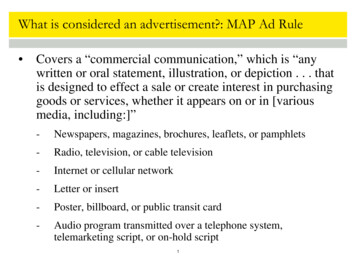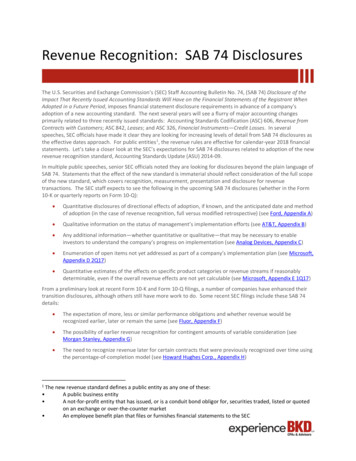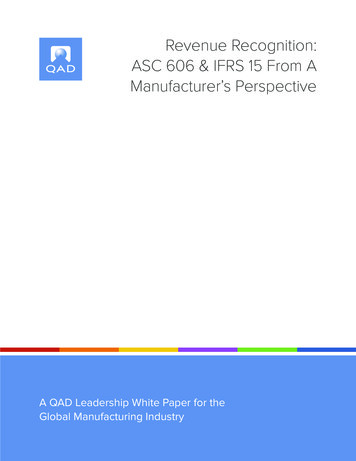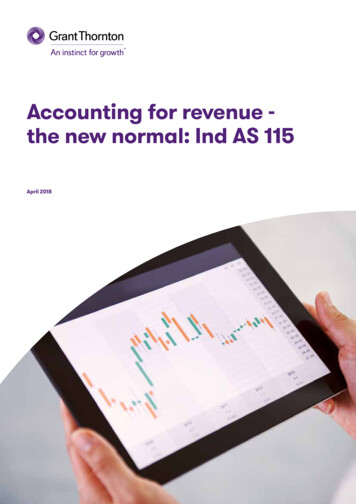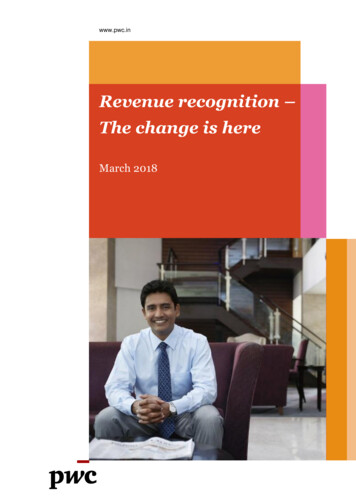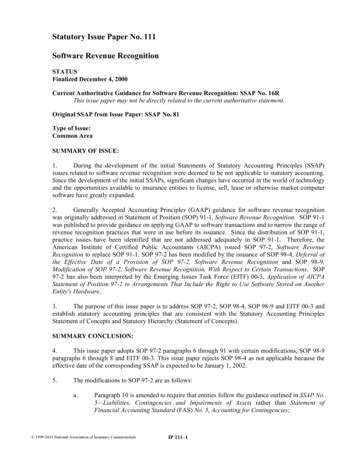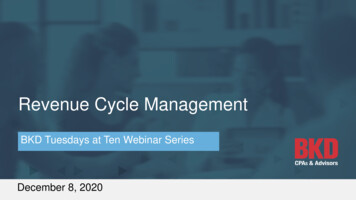
Transcription
Revenue Recognition: New DisclosuresStep 1 Identifycontract withcustomerStep 2 IdentifyperformanceobligationsStep 3 DeterminetransactionpriceStep 4 AllocatetransactionpriceStep 5 RecognizerevenueDisclosuresThe deadline for adoption of the new revenue recognition guidance is fast approaching. For public entities 1,implementation is required for the 2018 financial statements. All other entities will have an additional year.Certain industries will see greater changes to revenue recognition than others; however, all entities will be subjectto extensive new disclosure requirements. In addition to affecting an entity’s internal controls and businessprocess around external financial reporting, the new standard will likely affect the core systems used to producethe numbers required in the quantitative disclosures. Feedback from companies with implementation effortsunderway have indicated disclosures requirements have proven to be more challenging than initially estimated.Do not wait to review disclosure requirements. Companies should be assessing this information simultaneouslywith their implementation of the standard’s recognition and measurement principles. Developing a disclosurerequirement working plan upfront can avoid duplication of efforts and make data gathering more efficient.Questions entities should consider: What controls are in place to test the completeness and accuracy of the information disclosed? Is the current accounting information system capable of providing the required information? Is the current accounting system within the scope of internal control over financial reporting? How do current-year acquisitions or divestitures affect the revenue disclosures? What qualitative information would the financial statement user find interesting to supplementquantitative information? Have there been material changes in the timing of when performance obligations will result in revenuerecognition? What payment terms, e.g., payments in arrears, milestones, contingent payments and postpaidcustomers, give rise to contract assets? How does the satisfaction of performance obligations correlate with customer payment? Are all significant judgments and estimates related to variable consideration, noncash consideration anddetermining the transaction price disclosed?The new revenue standard defines a public entity as any one of these:A public business entityA not-for-profit entity that has issued, or is a conduit bond obligor for, securities traded, listed or quotedon an exchange or over-the-counter market An employee benefit plan that files or furnishes financial statements to the U.S. Securities and ExchangeCommission1
Revenue Recognition: New Disclosures Has the entity adequately disclosed information about the methods, inputs and assumptions used in theannual financial statements? What judgments are made in selecting an appropriate measure of progress? What estimates help determine the level of completion? What information does management consider to determine when performance obligations are satisfied?Even if the timing or amount of revenue recognized is not affected by the new revenue standard, disclosures willchange.Internal ControlsEntities should consider the need to design and implement new internal controls or modify existing controls toaddress risk areas resulting from the new processes, judgments and estimates. New risk areas may arise fromchanges to information technology systems and reports that provide data inputs used to support the newestimates and judgments. To the extent that data are needed to comply with the standard’s requirements,entities will need to consider the internal controls that will be necessary to ensure the completeness and accuracyof this information, especially if the data were not previously captured.Initial Adoption TimingU.S. Securities and Exchange Commission (SEC) registrants are required to provide both annual and interimdisclosures in the first interim period after the adoption of new accounting standards and in each subsequentquarter in the year of adoption, to the extent they are not duplicative.New DisclosuresObjectiveThe objective of the disclosure requirements is to enable financial statement users to understand the nature,amount, timing and uncertainty of revenue and cash flows arising from contracts with customers.Current disclosure requirements are included in industry-specific and general recognition standards, but arelimited and lack cohesion. The SEC also requires certain revenue disclosures for publicly traded companies.Current disclosure requirements include: General requirements – accounting policies, seasonal revenue, segments, related parties Specific requirements – multiple-element arrangements, nonmonetary revenue transactions, bill-andhold, fees for services Industry requirements – construction contractors, franchisorsThe new disclosure requirements reflect the belief that disclosure should be more than just a compliance exercise.Qualitative information will be just as important as quantitative information for helping the reviewer betterunderstand the nature of the organization’s contract revenue. Companies should avoid standard “boilerplate”language.Revenue from Contracts with CustomersAn entity shall disclose all of the following amounts for the reporting period unless those amounts are separatelypresented in the financial statements:2
Revenue Recognition: New Disclosures Revenue recognized from contracts with customers, which the entity shall separately disclose from itsother sources of revenue Any impairment losses recognized (in accordance with Topic 310 on receivables) on any receivables orcontract assets arising from an entity’s contracts with customers, which the entity shall separatelydisclose from impairment losses from other contractsAn entity must determine which of its contracts or revenue streams are accounted for in accordance withAccounting Standards Codification (ASC) 606 rather than in accordance with guidance on other revenuetransactions, e.g., financial instruments (interest income), leases (lease income) or insurance contracts. Forexample, an entity may be a lessor and derive revenue from its leasing operations in addition to various services itprovides in contracts with customers. Some contracts with customers (or portions of them) are outside of ASC606’s scope. In those circumstances, unless the lessor’s two sources of revenue are separately presented in theincome statement, the lessor must disclose the breakdown of those two revenue sources:Revenue from contracts with customers 6,000Interest income2,000Lease income3,000Revenue 11,000Disaggregation of Revenue from Contracts with CustomersThe first set in planning for the new disclosure requirements is determining the correct level of detail for financialstatement reporting. Revenue from contracts with customers must be disaggregated according to the nature,amount, timing and uncertainty of revenue and cash flows. This will require significant judgment. Informationcannot be obscured by too much insignificant detail or aggregation of items with different characteristics. Thedisaggregated revenue must be reconciled to the revenues in the financial statements. The Financial AccountingStandards Board (FASB) did not prescribe a specific characteristic of revenue as the basis for disaggregationbecause it intended for entities to make this determination based on entity-specific and/or industry-specificfactors that would be most meaningful for their businesses. An entity may need to use more than one type ofcategory to disaggregate its revenue.Segment disclosures may not be sufficiently disaggregated to achieve the disclosure objectives. Segmentdisclosures on revenue may not always provide users of financial statements with enough information to helpthem understand the composition of revenue recognized in the period.Examples of categories that might be appropriate include, but are not limited to, all of these: Type of good or service, e.g., major product lines Geographical region, e.g., country or region Market or type of customer, e.g., governmental and nongovernmental customers Type of contract, e.g., fixed-price and time-and-materials contracts Contract duration, e.g., short-term and long-term contracts Timing of transfer of goods or services, e.g., revenue from goods or services transferred to customers at apoint in time and revenue from goods or services transferred over time Sales channels, e.g., goods directly sold to consumers and goods sold through intermediaries3
Revenue Recognition: New DisclosuresWhen selecting the type of category (or categories) to use to disaggregate revenue, an entity should consider howinformation about the entity’s revenue has been presented for other purposes, including all of these: Disclosures presented outside the financial statements, e.g., in earnings releases, annual reports orinvestor presentations Information regularly reviewed by the chief operating decision maker for evaluating the financialperformance of operating segments Other information that is similar to the types of information identified in (a) and (b) and used by the entityor users of the entity’s financial statements to evaluate the entity’s financial performance or makeresource allocation decisionsPublic companies are required to provide a quantitative disclosure. Information about performance obligations, including when the entity typically satisfies performanceobligations, e.g., upon shipment, upon delivery or as services are rendered Significant payment terms (when payment is due, variable consideration and significant financingcomponents) Nature of goods and services Obligations for returns, refunds and similar obligations Types of warranties and related obligationsNonpublic entities may elect to only disclose qualitative information about how economic factors affect thenature, timing and uncertainty of revenue and cash flows.These disclosures do not need to be in a particular format; as a result, some entities may describe the interactionbetween the two required disclosures in the revenue footnote, while others may include the disclosures in thesegment footnote. In addition, since the guidance is not prescriptive, the disclosures also may be presented in atabular or narrative format.The standard provided these examples:Example: Disaggregation of Revenue—Quantitative DisclosureAn entity reports the following segments: consumer products, transportation and energy in accordance with Topic280 on segment reporting. When the entity prepares its investor presentations, it disaggregates revenue intoprimary geographical markets, major product lines and timing of revenue recognition, i.e., goods transferred at apoint in time or services transferred over time.The entity determines that the categories used in the investor presentations can be used to meet the objective ofthe disaggregation disclosure requirements, which is to disaggregate revenue from contracts with customers intocategories that depict how the nature, amount, timing and uncertainty of revenue and cash flows are affected byeconomic factors. The following table illustrates the disaggregation disclosure by primary geographical market,major product line and timing of revenue recognition, including a reconciliation of how the disaggregated revenueties in with the consumer products, transportation and energy segments.Public companies would be required to disclose the following:4
Revenue Recognition: New DisclosuresContact BalancesThe disclosure requirements have been developed to allow financial statement users to understand therelationship between the revenue recognized and changes in the overall balances of an entity’s total contractassets and liabilities during a particular reporting period.Disclosing contract assets and liabilities and the revenue recognized from changes in contract liabilities andperformance obligations satisfied in previous periods will likely be a change in practice for most entities.Some industries may already provide “backlog” information or have information readily available to producethese disclosures. The backlog definition varies from industry to industry and may not be consistent with thenew required disclosures. In addition, the requirement to disclose revenue recognized in the reporting periodfrom performance obligations satisfied (or partially satisfied in previous periods) may require additionalinformation.Required information includes: Opening and closing balances of receivables, contract assets and contract liabilities (if not presentedelsewhere) Amount of revenue recognized that was included in the contract liability balance at the beginning of theperiod How the timing of satisfaction of its performance obligations relates to the typical timing of payment andthe effect on the contract asset or liability. The explanation provided may use qualitative information Quantitative and qualitative description of significant changes, which could include changes due tobusiness combinations, impairment, changes in estimates, timing or measure of progressFASB has provided relief for nonpublic entities. Nonpublic entities may elect to only disclose the opening andclosing balances of receivables, contract assets and contract liabilities from contracts with customers, if nototherwise separately presented or disclosed.Entities are permitted to use different descriptions of contract assets, contract liabilities and receivables andcould use additional line items to present those assets and liabilities if the entity also provides sufficientinformation for financial statement users to distinguish them.5
Revenue Recognition: New DisclosuresThe Transition Resource Group addressed several questions about the presentation of contract assets: Should the contract assets, contract liabilities and receivables be offset and a net asset or liability bepresented in the statement of financial position?o Contract assets or liabilities are presented for each contract on a net basis. For contractsmeeting the criteria for combination under the new guidance, a contract asset or liability wouldbe presented for the combined contract net.In contracts with multiple performance obligations, how should a contract liability, e.g., advance received,be set off as the entity satisfies performance obligations?oThe contract—not individual performance obligations—is the unit of account for presentingcontract assets and liabilities.Excerpt from General Dynamics 1Q17 10-Q SEC filingContract Balances. The timing of revenue recognition, billings and cash collections results in billed accountsreceivable, unbilled receivables (contract assets), and customer advances and deposits (contract liabilities) onthe Consolidated Balance Sheet. In our defense groups, amounts are billed as work progresses in accordancewith agreed-upon contractual terms, either at periodic intervals (e.g., biweekly or monthly) or upon achievementof contractual milestones. Generally, billing occurs subsequent to revenue recognition, resulting in contractassets. However, we sometimes receive advances or deposits from our customers, particularly on ourinternational contracts, before revenue is recognized, resulting in contract liabilities. These assets and liabilitiesare reported on the Consolidated Balance Sheet on a contract-by-contract basis at the end of each reportingperiod. In our Aerospace group, we generally receive deposits from customers upon contract execution and uponachievement of contractual milestones. These deposits are liquidated when revenue is recognized. Changes inthe contract asset and liability balances during the three-month period ended April 2, 2017, were not materiallyimpacted by any other factors.Revenue recognized for the three-month periods ended April 2, 2017, and April 3, 2016, that was included in thecontract liability balance at the beginning of each year was 1.7 billion and 1.4 billion, respectively, andrepresented primarily revenue from the sale of business-jet aircraft.Performance ObligationsThe standard adds disclosures about performance obligations to help financial statement users understand therelationship between a company’s revenue accounting policies and its contracts with customers. All entities arerequired to disclose general information about performance obligations: When the entity typically satisfies its performance obligations, e.g., upon shipment, upon delivery, asservices are rendered or upon completion of service, including when performance obligations are satisfiedin a bill-and-hold arrangement Significant payment terms, e.g., when payment typically is due, whether the contract has a significantfinancing component, whether the consideration amount is variable and whether the estimate of variableconsideration is typically constrained The nature of the goods or services that the entity has promised to transfer, highlighting any performanceobligations to arrange for another party to transfer goods or services, i.e., if the entity is acting as anagent Obligations for returns, refunds and other similar obligations Types of warranties and related obligations6
Revenue Recognition: New DisclosuresExcerpt from Ford Motor Company 1Q17 10-Q SEC filingRevenue is recognized when obligations under the terms of a contract with our customer are satisfied; generallythis occurs with the transfer of control of our vehicles, parts, accessories, or services. Revenue is measured asthe amount of consideration we expect to receive in exchange for transferring goods or providing services. Sales,value add, and other taxes we collect concurrent with revenue-producing activities are excluded from revenue.Incidental items that are immaterial in the context of the contract are recognized as expense. The expectedcosts associated with our base warranties and field service actions continue to be recognized as expense whenthe products are sold. We recognize revenue for vehicle service contracts that extend mechanical andmaintenance beyond our base warranties over the life of the contract.Other Revenue. Other revenue consists primarily of net commissions received for serving as the agent infacilitating the sale of a third party’s products or services to our customers and payments for vehicle-relateddesign and testing services we perform for others. We have applied the practical expedient to recognizeAutomotive revenues for vehicle-related design and testing services over the two to three year term of theseagreements in proportion to the amount we have the right to invoice.Excerpt from Raytheon 1Q17 10-Q SEC filingThe portion of the payments retained by the customer until final contract settlement is not considered asignificant financing component because the intent is to protect the customer. For our U.S. government costtype contracts, the customer generally pays us for our actual costs incurred within a short period of time. Fornon-U.S. government contracts, we typically receive interim payments as work progresses, although for somecontracts, we may be entitled to receive an advance payment. We recognize a liability for these advancepayments in excess of revenue recognized and present it as contract liabilities on the balance sheet. Theadvance payment typically is not considered a significant financing component because it is used to meetworking capital demands that can be higher in the early stages of a contract and to protect us from the otherparty failing to adequately complete some or all of its obligations under the contract.Remaining Performance ObligationsPublic entities1 also are required to disclose information about remaining performance obligations and the amountof the transaction price allocated to such obligations, including an explanation of when it expects to recognize theamounts in its financial statements.A technical correction in Accounting Standards Update 2016-20 reordered some of the disclosure requirements toclarify that the disclosure of revenue recognized from performance obligations satisfied (or partially satisfied) inprevious periods applies to all performance obligations and is not limited to performance obligations withcorresponding contract balances.7
Revenue Recognition: New DisclosuresPractical Expedients for Remaining Performance Obligations1. An entity need not disclose this information for a performance obligation if either condition is met:less.a. The performance obligation is part of a contract with an original expected duration of one year orb. The entity recognizes revenue in the amount to which the entity has a right to invoice.2. An entity need not disclose this information for variable consideration if either condition is met:a. The variable consideration is a sales-based or usage-based royalty for a license of intellectualproperty.b. The variable consideration is entirely allocated to a wholly unsatisfied performance obligation or awholly unsatisfied promise to transfer a distinct good or service that forms part of a single performanceobligation under the series provision.If either expedient is elected, additional disclosure is required. An entity shall disclose which optionalexemptions it is applying as well as the nature of the performance obligations, the remaining duration and adescription of the variable consideration that has been excluded. An entity shall explain whether anyconsideration is not included in the transaction price and, therefore, not included in the information disclosed,e.g., an estimate of the transaction price would not include any estimated amounts of variable considerationthat are constrained.The standard provides these examples:Example: Disclosure of the Transaction Price Allocated to the Remaining Performance ObligationsOn June 30, 20X7, an entity enters into three contracts (Contracts A, B and C) with separate customers to provideservices. Each contract has a two-year noncancellable term.Contract ACleaning services are to be provided for the next two years, typically at least once per month. For servicesprovided, the customer pays an hourly rate of 25. Because the entity bills a fixed amount for each hour of serviceprovided, the entity has a right to invoice the customer in the amount that directly corresponds with the value ofthe entity’s performance completed to date. The entity could elect to apply the optional exemption. If the entityelects not to disclose the transaction price allocated to remaining performance obligations for Contract A, theentity would disclose that it has applied the optional exemption and the nature of the performance obligation, theremaining duration and a description of the variable consideration excluded from the disclosure of remainingperformance obligations.Contract BCleaning and lawn maintenance services are to be provided as and when needed with a maximum of four visits permonth for the next two years. The customer pays a fixed price of 400 per month for both services. The entitymeasures its progress toward complete satisfaction of the performance obligation using a time-based measure.The entity discloses the amount of the transaction price that has not yet been recognized as revenue in a tablewith quantitative time bands that illustrates when the entity expects to recognize the amount as revenue. Theinformation for Contract B included in the overall disclosure is as follows.8
Revenue Recognition: New Disclosures20X820X9TotalRevenue expected to be recognized on this contract as of December 31, 20X7 4,800 (a) 2,400 (b) 7,200(a) 4,800 400 12 months(b) 2,400 400 6 monthsContract CCleaning services are to be provided as and when needed for the next two years. The customer pays fixedconsideration of 100 per month plus a one-time variable consideration payment ranging from 0 to 1,000corresponding to a one-time regulatory review and certification of the customer’s facility, i.e., a performancebonus. The entity estimates that it will be entitled to 750 of the variable consideration. On the basis of theentity’s assessment of the factors in paragraph 606-10-32-12, the entity includes its estimate of 750 of variableconsideration in the transaction price because it is probable that a significant reversal in the amount of cumulativerevenue recognized will not occur. The entity measures its progress toward complete satisfaction of theperformance obligation using a time-based measure.The entity discloses the amount of the transaction price that has not yet been recognized as revenue in a tablewith quantitative time bands that illustrates when the entity expects to recognize the amount as revenue. Theentity also includes a qualitative discussion about any significant variable consideration that is not included in thedisclosure. The information for Contract C included in the overall disclosure is as follows:20X820X9TotalRevenue expected to be recognized on this contract as of December 31, 20X7 1,575 (a) 788 (b) 2,363(a)Transaction price 3,150 ( 100 24 months 750 variable consideration) recognized evenly over 24months at 1,575 per year(b) 1,575 2 788 (that is, for six months of the year)In addition, the entity qualitatively discloses that part of the performance bonus has been excluded from thedisclosure because it was not included in the transaction price. That part of the performance bonus was excludedfrom the transaction price in accordance with the guidance on constraining estimates of variable consideration.The entity does not meet the criteria to apply the optional exemption because the monthly consideration is fixedand the variable consideration does not meet the conditions specified.Example: Disclosure of the Transaction Price Allocated to the Remaining PerformanceObligations—Qualitative DisclosureOn January 1, 20X2, an entity enters into a contract with a customer to construct a commercial building for fixedconsideration of 10 million. The construction of the building is a single performance obligation that the entitysatisfies over time. As of December 31, 20X2, the entity has recognized 3.2 million of revenue. The entityestimates that construction will be completed in 20X3 but it is possible that the project will be completed in thefirst half of 20X4.At December 31, 20X2, the entity discloses the amount of the transaction price that has not yet been recognized asrevenue in its disclosure of the transaction price allocated to the remaining performance obligations. The entityalso discloses an explanation of when the entity expects to recognize that amount as revenue. The explanationcan be disclosed either on a quantitative basis using time bands that are most appropriate for the duration of theremaining performance obligation or by providing a qualitative explanation. Because the entity is uncertain aboutthe timing of revenue recognition, the entity qualitatively discloses this information as follows:9
Revenue Recognition: New DisclosuresAs of December 31, 20X2, the aggregate amount of the transaction price allocated to the remaining performanceobligation is 6.8 million, and the entity will recognize this revenue as the building is completed, which is expectedto occur over the next 12 to 18 months.Significant JudgmentsThe new revenue standard significantly expands current disclosure requirements related to judgments associatedwith revenue recognition due to the importance placed on revenue by financial statement users. FASB hasprovided some relief for companies that do not meet the definition of a public entity1. Private companies mayelect not to disclose the items underlined.General Timing of satisfaction of performance obligations The transaction price and the allocations to performance obligationsTiming of Satisfaction of Performance Obligations For obligations satisfied over time:The methods used to recognize revenue, e.g., a description of the output or input methods used andhow those methods are applied)o An explanation of why the methods used provide a faithful depiction of the transfer of goods orservicesFor obligations satisfied at a point in time:o oJudgments made in evaluating when a customer obtains controlExcerpt from Raytheon 1Q17 10-Q SEC filingWe generally recognize revenue over time as we perform because of continuous transfer of control to thecustomer. For U.S. government contracts, this continuous transfer of control to the customer is supported byclauses in the contract that allow the customer to unilaterally terminate the contract for convenience, pay us forcosts incurred plus a reasonable profit and take control of any work in process. Similarly, for non-U.S.government contracts, the customer typically controls the work in process as evidenced either by contractualtermination clauses or by our rights to payment for work performed to date plus a reasonable profit to deliverproducts or services that do not have an alternative use to the Company.Because of control transferring over time, revenue is recognized based on the extent of progress towardscompletion of the performance obligation. The selection of the method to measure progress towards completionrequires judgment and is based on the nature of the products or services to be provided. We generally use thecost-to-cost measure of progress for our contracts because it best depicts the transfer of assets to the customerwhich occurs as we incur costs on our contracts. Under the cost-to-cost measure of progress, the extent ofprogress towards completion is measured based on the ratio of costs incurred to date to the total estimatedcosts at completion of the performance obligation. Revenues, including estimated fees or profits, are recordedproportionally as costs are incurred. Costs to fulfill include labor, materials and subcontractors’ costs, otherdirect costs and an allocation of indirect costs including pension and any other postretirement benefit (PRB)expense under U.S. government Cost Accounting Standards (CAS)
these disclosures. The backlog definition varies from industry to industry and may not be consistent with the new required disclosures. In addition, the requirement to disclose revenue recognized in the reporting period from performance obligations satisfied (or partially satisfied in previous periods) may require additional information.


